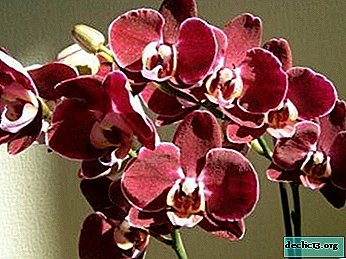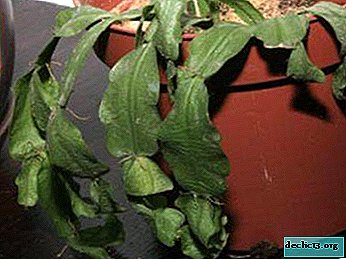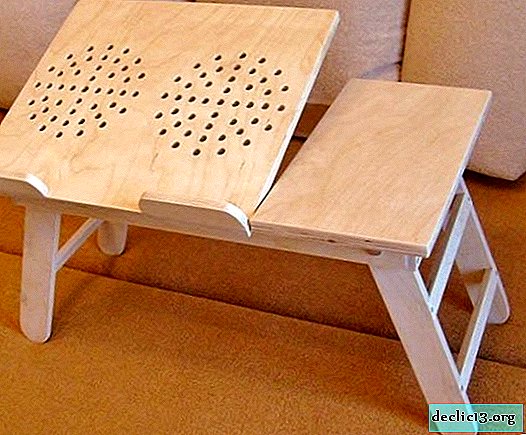Decoration of gardens and parks - climbing rose Rosarium Uetersen. Description, photo, nuances of growing

In the now popular vertical gardening system, climbing roses are again in demand. But not only modern landscape designers use a climbing plant, homeowners also appreciated the beneficial qualities of roses.
It is used to create flower arches, decorate fences and walls. And the right combination of climbing roses with other climbing plants will turn the site into a real elegant flower garden.
Grade description
Rosarium Uetersen is characterized by large, densely doubled quartered flowers.. Their diameter is 10 cm. Petals each about 100 pieces. Branches form lush brushes (up to 5 buds) with bright pink, coral inflorescences. The reverse side of the petals has a silver tint, and when buds appear, a spectacular contrast is obtained.
Powerful bush with strong, prickly shoots. It grows up to 3.5 meters high, 2.5 meters wide. The leaves have a deep green color, medium size, thick, the surface is glossy. Flowering is plentiful, long, repeated. The variety is resistant to fungal diseases, rain, wind. Frost resistance zone 5.
Photo
Below you can see a photo of the flower.





History of occurrence
Selection production of W. Kordes Sohne has produced more than a dozen varieties of roses. And climbing The Rosarium Uetersen rose was bred through the joint efforts of the Wilhelm Cordes family in 1977. This flower was obtained by crossing varieties Karlsruhe and seedling. Since then, the climbing plant has been recognized worldwide. She has accounted for more than 13 ARS awards in the Climbing Rose category.
Distinctive features
This variety of climbing roses did not immediately appeal to lovers of the beautiful, as it was considered old-fashioned and did not correspond to the trends of that time.
- Firstly, the shape of the inflorescences, which varies from pointed buds to open flat cups.
- Secondly, volume: terry adds size and it seems that the petals are stacked in the form of English ladies' caps.
However, now ancient motifs have become a real trend, pushing tea-hybrid representatives into the background.
Bloom
Rosary Utersen blooms for the first time at the very beginning of June. The maximum number of inflorescences appear in mid-July. The flowering process is plentiful. Rosettes are quite resistant to precipitation, adverse environmental conditions. The second phase of flowering is not as magnificent as the first, but long. Buds form until September.
Care before and after
 Care for the climbing rose is:
Care for the climbing rose is:
- In the systematic prevention of the appearance of a surface crust, loosening the soil every 2-3 days.
- Regular weed removal.
- In early March, they begin to make top dressing, once every 7 days. As fertilizers, choose ammonium nitrate or urea.
- Long lashes should be tied up as soon as possible, which will save the owner from subsequent troubles and set the right direction of growth.
- Closer to the time of budding, potash fertilizers are used.
After flowering:
- A climbing rose must be correctly trimmed. Remove dry inflorescences, damaged lashes, if necessary, thin out the overgrown bush.
- After feeding the plant with universal mineral fertilizers.
- After autumn flowering, one or two flowers are left on each lash, so that the fruits are tied. Thus, the shoots will overwinter better, gain strength, and the next year will bloom profusely.
What to do if it does not bloom?
If the climbing rose does not bloom, there are a number of reasons. Among them: the wrong composition of the soil, the wrong place of planting, poor wintering, the wrong choice of fertilizers and their use. In order for the plant to bloom, the parameters of care and winter rest should be corrected.
Step-by-step care instructions
Caring for the rosary has certain nuances, without which it will not be possible to achieve lush and regular flowering.
Seat selection
For the flower, the sunniest place is suitable, which is still protected from the north wind and drafts. But at the same time, good air exchange is needed. It is worth finding out the groundwater level on the site. Their bedding should not exceed the mark of 1.5 meters.
Important. You can not plant a rose in dark, damp places under the crowns of shady trees.What should be the soil?
 Utersen should be planted in well-drained, fertile soil. The optimal pH of the soil is 5.5-7.0. Clayy, sandy lands are not suitable for growing climbing flowers. To obtain lightness and friability, the earth is diluted with peat, sand, compost.
Utersen should be planted in well-drained, fertile soil. The optimal pH of the soil is 5.5-7.0. Clayy, sandy lands are not suitable for growing climbing flowers. To obtain lightness and friability, the earth is diluted with peat, sand, compost.
For roses, the following soil composition is suitable:
- fertile layer of the earth - 2 parts;
- sand - 2 parts;
- peat - 1 part;
- wood ash - 2 parts;
- manure - 3 parts.
It is not recommended to plant roses in acidified soil, with poor air and water permeability.
Landing
Planting events must be arranged in Aprilwhen the earth warmed up to + 10 ° С. In the southern regions of the country, the autumn season is also suitable. It is advisable to choose grafted cuttings purchased at trusted, specialized points of sale.
- Prepare a pit measuring 40x40 cm and a depth of 50 cm.
- Drainage is poured to the bottom, in the form of chipped brick, crushed stone or small pebbles. At least 30 cm should remain to the top of the pit.
- Properly planted cuttings so that the neck was below the ground by 3 cm, which prevents drying out or freezing.
- Bushes should be placed at a distance of two meters from each other.
- The procedure must be performed in a calm, cool weather, preferably in the evening.
- After a new plant, water abundantly.
Temperature
Rosarium Yutersen is a frost-resistant variety with good immunity. It belongs to the 5th zone of the climatic zone (St. Petersburg and the region, Moscow, Moscow region, the middle zone of Russia). This plant is able to withstand a minimum temperature of -29 ° C. The maximum parameters in the summer are + 30-35 ° C. The optimum temperature range is considered to be + 18-22 ° С.
Watering
In dry moments, be sure to water the bush. The procedure is preferably performed every 3-5 days. Water must be taken warm, defended with a volume of 15-20 liters under the bush. A couple of days after irrigation, they will certainly loosen the earth to facilitate the access of oxygen to the roots. With the onset of autumn, watering is reduced to nothing.
Pruning
With the help of trimming, an attractive, well-groomed crown is achieved. In this variety, flowers appear on the lashes of the current or last year, so it is worth observing their number. A flowering shoot is left, and young shoots that do not have inflorescences are removed.
Important. Cut the rose with an exceptionally sharp, sanitized tool.How to tie plants?
 Another important point regarding climbing roses is tying. However, this is not possible without special support. It is important to build a design for curly flowers, thanks to which they will develop correctly. Supports can be in the form of:
Another important point regarding climbing roses is tying. However, this is not possible without special support. It is important to build a design for curly flowers, thanks to which they will develop correctly. Supports can be in the form of:
- arches;
- grids;
- conical design.
To them with the help of small ropes attached climbing branches. It is better not to use metal wire, otherwise you can damage the whips.
Variety Rosarium Uetersen has a large number of sharp thorns. Therefore, for safety reasons, protective gloves must be worn.
Transfer
Experienced growers are advised to transplant in early autumnuntil the roots began to adapt to cold weather, or in early spring before the buds appear.
- To do this, carefully dig out the recess and carefully remove the flower.
- Inspect the root system: leave healthy, dense shoots, remove excess ones with secateurs.
- When planting a plant, it is necessary to spread the roots in a new pit so that they do not stick up.
- Then cover with earth and water.
Preparation for winter
For wintering to be successful, you should prepare in the fall.
- In September, remove unblown buds, faded flowers.
- In October, trim unformed, weak shoots.
- In adult lashes, trim the ends by 10-20 cm and tie them together.
- The variety has strong enough shoots that are difficult to tilt. To do this, use metal arcs for greenhouses. They will not allow the shoots to disperse.
- The flower should be completely covered when the temperature in the street drops to -10 ° C, otherwise the plant will mate.
Step-by-step instructions for reproduction
This variety of climbing roses is planted with cuttings or layering.
Cuttings
They start training in late spring, but better in summer:
- Make cuttings from the middle of a faded whip, 15 cm long.
- Such blanks are immersed in a moist substrate and covered with a transparent cap. In this form, the stalk is until the roots appear.
- The resulting plant can be planted in open ground only for the third season.
Layering
- The lower lash is bent, fixed with brackets and instilled with earth.
- A year later, the process is separated.
- In winter, a young sprout is sheltered along with the mother plant.
Diseases and Pests
 This climbing rose variety is resistant to fungal diseases., therefore, powdery mildew, black spotting, she is not afraid. Sometimes damaged by rust or gray rot. They can be dealt with using drugs containing copper.
This climbing rose variety is resistant to fungal diseases., therefore, powdery mildew, black spotting, she is not afraid. Sometimes damaged by rust or gray rot. They can be dealt with using drugs containing copper.
It happens that harmful insects also disturb the plant. The fight against them is possible with the help of insecticides. However, once for complete disposal of pests is not enough, it is advisable to perform 2-3 treatments.
Landscape designers recommend planting a Rosarium Uetersen rose in rose gardens, flower beds, combining it with white-flowered or cream roses. The duet of a climbing beauty with clematis in red, white or purple colors also looks good.

















